The road to a good story is never straight. Neither is it flat. In fact, it’s the twists and turns and the hills and valleys that make a story interesting. How can you visualize these twists and turns? One model is Freytag’s Pyramid, a simplified approach to dramatic structure. Read on to learn more, including how to use Plottr’s Freytag’s Pyramid plot template.
What is Freytag’s Pyramid?
Developed by German novelist and playwright Gustav Freytag in the 19th century, Freytag’s Pyramid details the classic stages of a fiction story.
The rise and fall of a compelling story become obvious at a glance when you see a graphic of Freytag’s Pyramid. It looks a bit like driving along the plains, approaching a mountain range, climbing to the peak, and then descending the opposite slope until you reach the plains again.
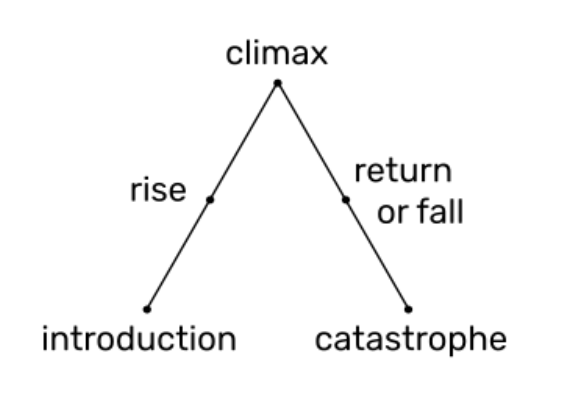
The pyramid is often cited as having five steps, sometimes with slightly different names. The Freytag’s pyramid plot template in Plottr is a version that includes a couple of extra steps.
All these parts of a story will be familiar; we’re exposed to them throughout our lives when we read, listen to, or watch stories.
Watch Plottr Education Lead Troy Lambert explain Freytag’s Pyramid below, and keep reading for step by step instructions on how to use the template in Plottr.
Who is the Freytag’s Pyramid Plot Structure For?
Whether you are writing a children’s tale or an action thriller, the dramatic arc outlined in Freytag’s Pyramid is useful for mapping and visualizing the rise and fall of your story. This natural way of telling stories has been around for centuries, and for good reason.
Any writer working in any genre can use this structure to:
- Ensure a story has a sense of rise and fall: a story without any kind of rise to a climax may read ‘flat’ and lacking in dramatic variation
- Make sure a climax feels earned and rings true: without a rise to a climax, with its sequence of cause and effect, the high point of dramatic tension and suspense may seem to come out of nowhere or may even feel unearned by preceding events
- See that no part of a story feels imbalanced or overlong: A story that is ninety percent introduction with rise, climax, and the other stages squashed into the last ten percent of story may seem imbalanced and lacking in pace. Freytag’s Pyramid helps you remember to parcel out your story’s segments
7 Plot Points of Freytag’s Pyramid
Let’s examine the seven steps you’ll find in the Freytag’s Pyramid plot structure template in Plottr.
Exposition
This story component introduces your protagonist, central characters, and their ordinary world, and hooks readers into the story. There might not be true action in this beat as it sets the scene and allows readers to see how things currently stand. In the end, it sets up the inciting incident.
Example: In the classic children’s tale Cinderella, the introduction shows the titular character is living with her evil stepmother and two stepsisters after the death of her mother and father. She is treated as a servant rather than a member of the family. Her only friends are animals such as mice and birds. Readers are quickly hooked by their sympathy for her circumstances.
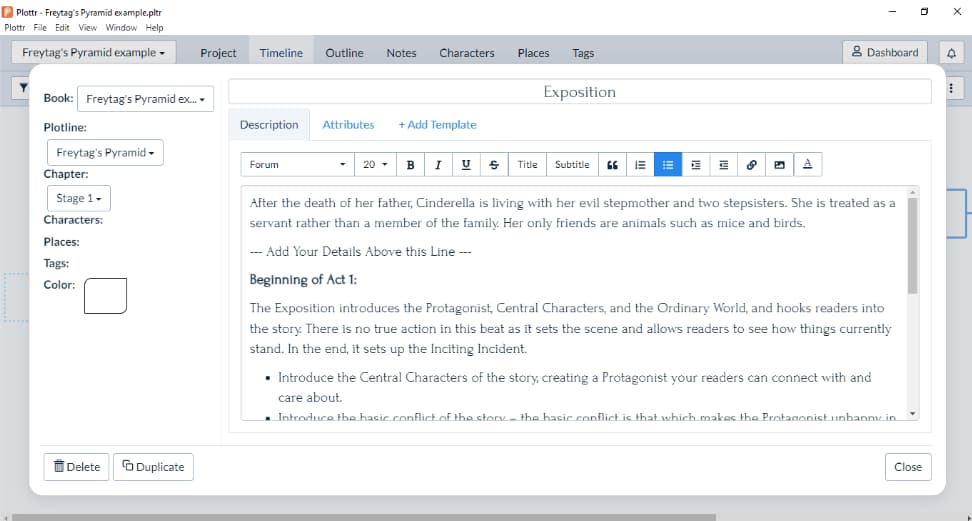
Inciting Incident
This is the first point of conflict and the moment that propels the protagonist into the story you’re beginning to unfold. This event triggers the central conflict of the story and must be one that cannot be resolved on its own.
Example: In the example of Cinderella, an invitation for all young women to attend a ball at the palace arrives because the prince is looking for a wife, causing excitement for Cinderella and her stepsisters.
Rising Action
In rising action, major events lead toward the climax while increasing the tension and stakes. This section explores the story’s conflict and complications while offering the reader key pieces of backstory. The protagonist’s motives are revealed along the way, as well as their inner conflict and the central theme of the story. The protagonist sees things go from bad to worse as the plot progresses.
Example: Cinderella’s stepmother says she can attend the ball only if she gets all her chores done and can find a suitable dress to wear. But in an effort to make sure that Cinderella can’t attend, her stepmother and stepsisters keep inventing tasks for her to complete. By the time she’s done, she believes there is no time to fix the old dress that belonged to her mother.
Cinderella is surprised when the animals reveal they have created a beautiful dress for her. When her stepsisters see that the dress includes a sash and beads they discarded, they destroy Cinderella’s dress. As she cries in the garden, her fairy godmother appears and presents her with a beautiful gown, glass slippers, a coach, horses, and a footman to escort her to the ball, where she dances with the prince and he falls in love with her.
Yet, as midnight approaches, Cinderella is forced to run away before her magical coach turns back into a pumpkin, the horses back into mice, the coachman into an old horse, and the footman back into a dog. As she runs away, she loses one of her glass slippers. The prince finds it and declares that he will only wed the woman who can wear the slipper.
Climax
Finally, we reach the crux of the story and the height of suspense and tension. This is the turning point for the story and protagonist, and it is important to put deliberate effort into writing this scene so that it has the appropriate impact on your readers.
In a tragedy, here is where everything turns and begins to fall apart. In a comedy, things have been difficult for the protagonist, but they start to improve from here.
Example: Cinderella, back in her old life, believes she’s lost the prince forever. Even when the Grand Duke arrives to see if anyone in her home can fit into the glass slipper, her stepmother locks Cinderella in her room, preventing her from revealing she’s the owner of the glass slipper.
Falling Action
The falling action explores the aftermath of the climax and contains a series of events that untangle the main conflict and lead to the story’s resolution.
Events continue to trend in a new direction for the protagonist as loose ends begin to close. Unexpected incidents add suspense to the final outcome, and the story starts winding down to its conclusion.
Example: The mice find the key to Cinderella’s room and she’s able to free herself in time to ask the Grand Duke if she can try on the slipper. Desperate for the prince to settle for one of her daughters instead of Cinderella, the stepmother trips the Grand Duke, causing him to drop and break the glass slipper.
Resolution
At this point, the story’s central conflict is resolved, and the protagonist has either succeeded and transformed or failed and remained stagnant.
In a tragedy, the catastrophe creates suffering for not only the protagonist but also those close to them. The resolution continues the story’s themes and leaves the reader with something to think about.
Example: Cinderella reveals that she has the matching glass slipper, and it fits!
Denouement
Your denouement wraps up all storylines and character arcs, and presents the ordinary world from a new perspective. This is a short scene to finalize the story’s details and show what life is like in the new normal of the ordinary world.
Example: The prince and Cinderella are married and live happily ever after.
You can also find an example of how these steps apply to William Shakespeare’s Hamlet within the Freytag’s Pyramid Plot Structure Template in Plottr.
How Do You Use the Freytag’s Pyramid Template in Plottr?
Ready to jump in? First, ensure you have Plottr set up on your system (or begin your free trial) and open the desktop or browser version of the application.
Once you’re ready, follow these easy steps to get started with the Freytag’s Pyramid Plot Structure Template:
- Step 1: Within the Files tab (on the left side of your screen), click Create From Template
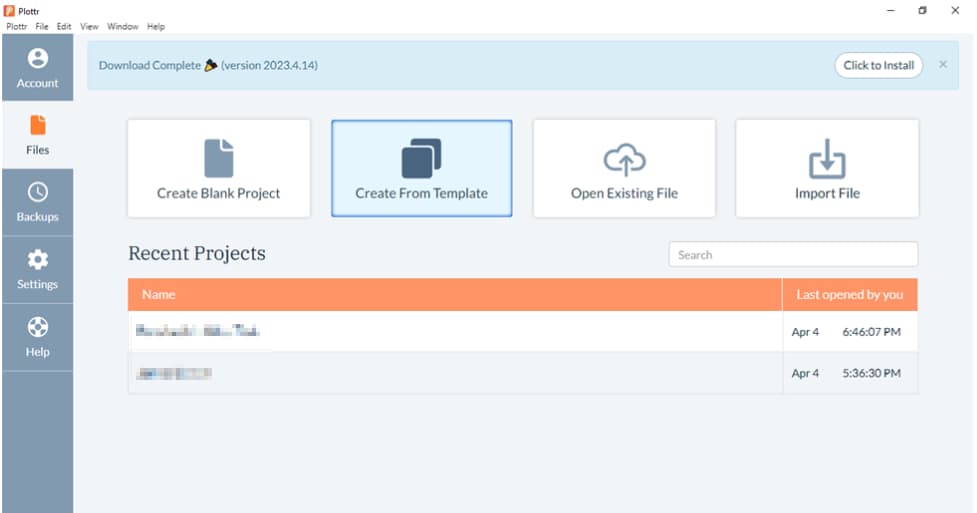
- Step 2: Choose Freytag’s Pyramid from the pull-down menu under Starter Templates. Click the orange Create New Project button in the bottom-right corner
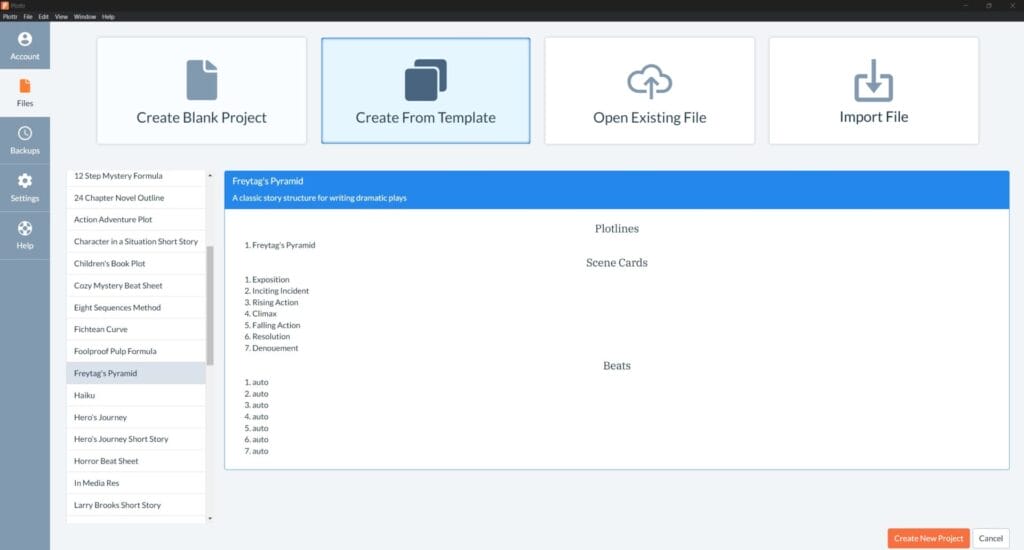
- Step 3: Name your project. Once it’s saved, you’ll be able to access it from your Plottr dashboard at any time.
- Step 4: You will see this timeline with the template applied
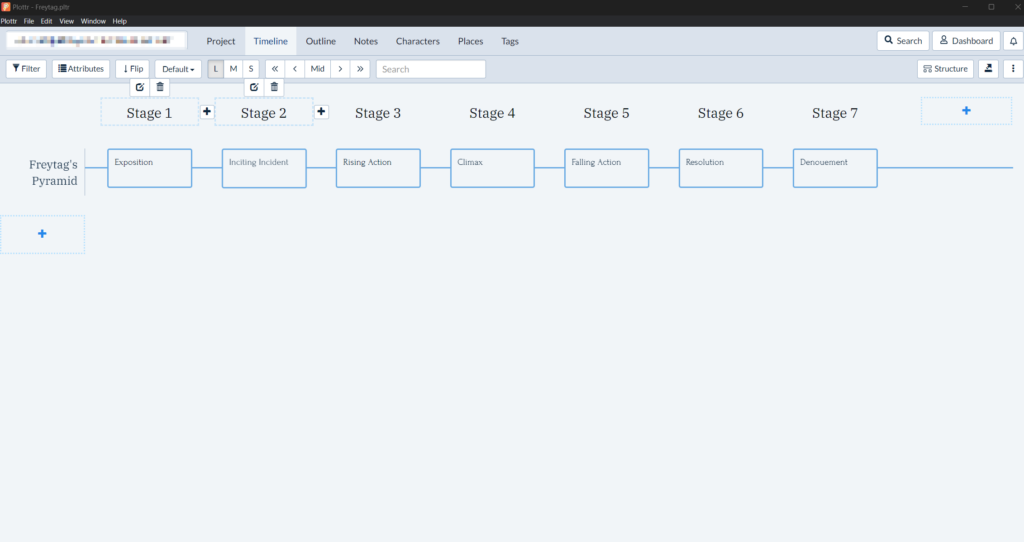
- Step 5: Fill out the stages’ cards! When you select a beat, it will give you details about what should go there and instructions to help you input your story details
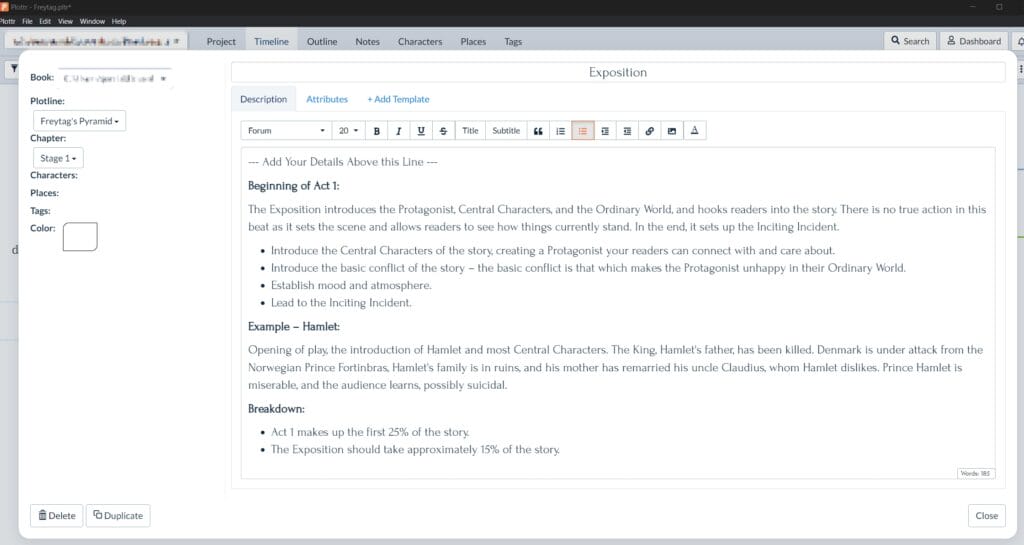
Once you have the dramatic structure of your story set up using the Freytag’s Pyramid Plot Template, you can use other templates for plotting the structure of individual scenes and secondary plot lines.
Note: At the end of each beat’s section description, you’ll see some breakdown information — such as how much of your book each part of the story should occupy. In the case of your Exposition beat, it’s 15%.
Time to Take Action
Want to try out Plottr’s Freytag’s Pyramid Plot Template? There’s no better time than now to open Plottr and get to work. If you don’t yet have Plottr, that’s an easy fix. Get a free Plottr trial and join free Plottr 101 tutorials on Tuesdays to learn how to get the most out of our story planning tools.
How are our plot templates working for you? Which is your favorite and why? Sound off below and comment!
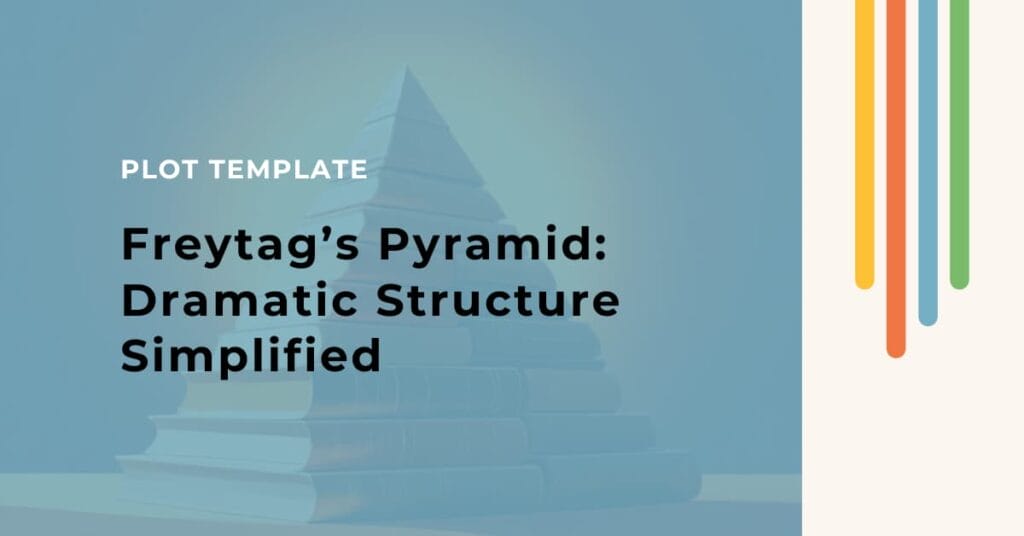

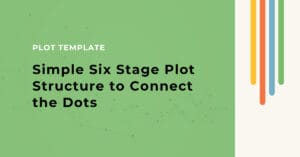





Comments